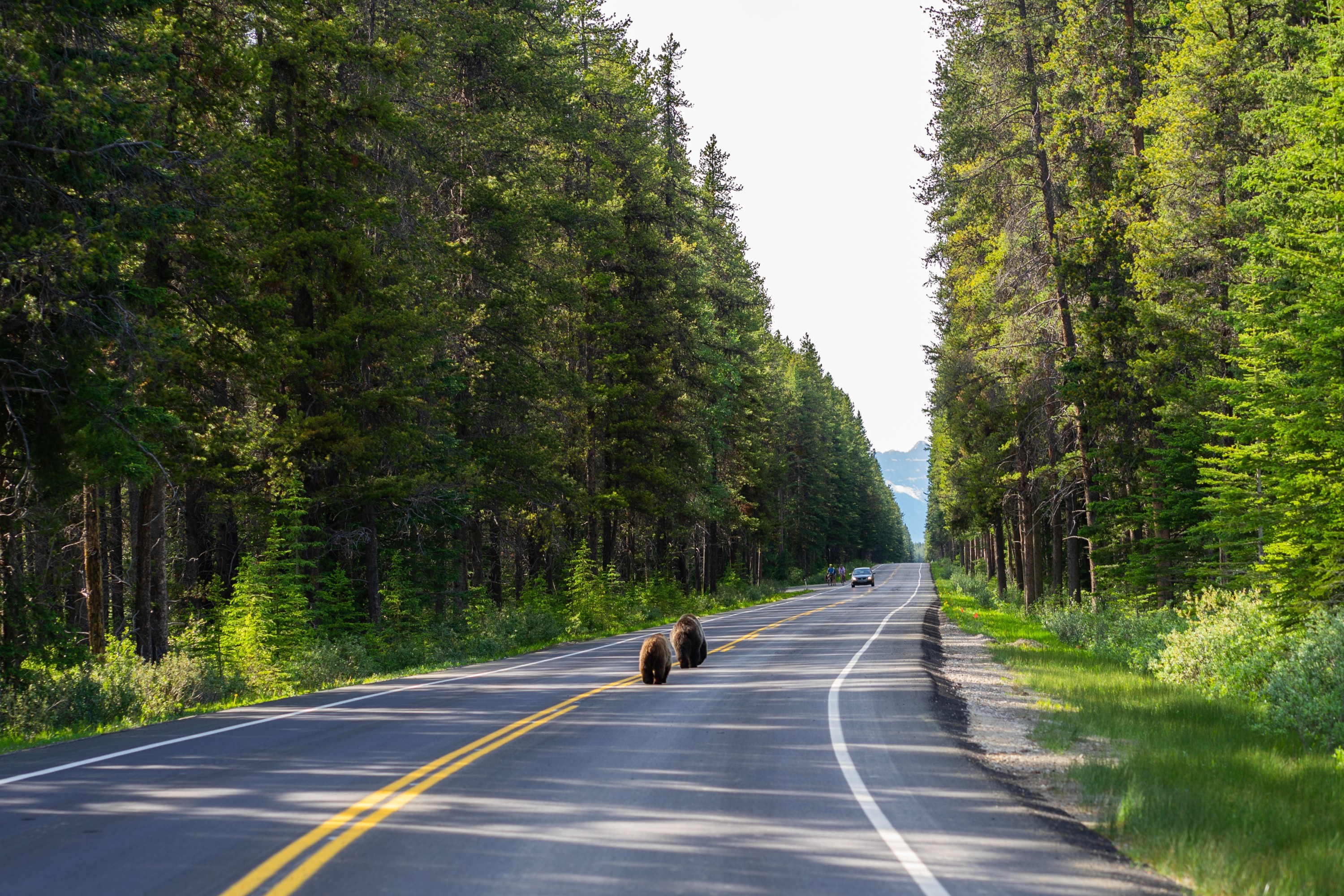Wildlife Encounters in Canada: How to Respect Predators and Stay Safe


Canada’s untouched terrains are teeming with wildlife, which can sometimes lead to surprise encounters when you are out exploring.
Wildlife viewing is a privilege–Canada’s animals have been around for over 23,000 years and it’s our responsibility as humans to prevent disturbances for them and their habitats.
There are specific safety precautions and etiquette for exploring the bush. This guide aims to educate hikers, trekkers and paddlers on how to prevent unfortunate encounters or accidents with wildlife along the way. From 500-pound grizzly bears to pods of orcas, learn how to behave accordingly if you come across these beautiful, yet fierce creatures in the wild.
We cover proper etiquette for encountering the four most common predators in the Canadian wilderness:
Encounters with Bears

Bear behaviour is often misinterpreted due to human fear. Bears are generally more predictable than people and are typically shy, preferring to avoid humans altogether, unless food sources are involved. Each bear has a "critical space" they may defend, and this varies depending on the bear and the situation. Black bears are known for their climbing abilities and usually retreat from threats. Grizzlies (especially mothers with cubs) may act aggressively.
Bears are curious, social animals that share home ranges and form social hierarchies based on age and size. They habituate to humans similarly to how they do with other bears, as long as they are not harassed.
When you are exploring Canada’s wilderness, announce your presence by making noise, especially in areas with dense brush or winding streams. You can clap, sing, talk loudly or attach a little bell to your backpack.
Keep your eye out for signs of bears, such as tracks, trampled foliage close to berry bushes, and droppings. If signs are fresh, relocate ASAP. If you have a high-energy dog, keep it on a leash. If you are in an area heavily populated by bears, opt to travel in a larger group. Properly dispose of fish refuse and smelly garbage promptly. Place refuse in a bear-proof garbage can or if you are camping with no facilities, use a rope to hang it high up in a tree.
Bear spray is essential when hiking. Carry it always and make sure you know how to use it properly, before you embark. Wind and temperature can affect its effectiveness.
In the case of a sudden up-close encounter, stay calm and don’t run. Prepare your bear spray and assess the situation. If the bear is ignoring you and unaware of your presence, quietly move farther away. If the bear does notice you, speak calmly but firmly and back away without running. Make yourself appear larger by picking up a large object such as a stick. Pick up your children if they are with you and stay in a group.
If there are cubs or a food source nearby, the bear could be in protection-mode and potentially defensive. Use bear spray if needed, and play dead if the bear makes contact. Do this by lying still until the bear leaves. For non-defensive predatory attacks, fight back aggressively while using anything you can find to show the bear you are not easy prey. Think rocks, sticks, etc.
Cyclists and trail runners should travel slowly and noisily, staying alert to avoid sudden encounters. When camping in the backcountry, set up camp in designated areas and mitigate attracting bears by securing uneaten food or burying food scraps.
READ: The Ultimate Guide to Canadian Wildlife: Where to See Iconic Animals
Encounters with Cougars

Also known as mountain lions in the United States, cougars are the fourth largest cat in the world. They have the fourth largest range of any wild animal in the Americas, up there with wolves, brown bears and moose. Impressive athleticism is an understatement–cougars can leap up to 7.6 metres!
If you come across a cougar in the wild, stay calm and keep the cougar in view. Back away slowly to provide the cat with a clear escape route. Making yourself appear larger and maintaining eye contact can deter the cougar. If a cougar shows interest or follows you, respond aggressively by making loud noises and showing your teeth. If attacked, fight back using any available objects as weapons, focusing on the cougar's face and eyes to convince it you are a threat and not prey.
Children are high-risk because they are small and move erratically, which attracts cougars. Educate children on cougar safety and response, and supervise them at all times. Pets are a target as well, however, dogs can be used as an early warning system.
When camping or hiking in a cougar country, keep pets leashed, make lots of noise to avoid surprise encounters, and watch for signs of cougars such as tracks or food caches. Travelling in groups and maintaining a clean camp can also reduce the risk of attracting cougars.
READ: Canada Through the Lens: A Photographer's Guide to Capturing the Landscape
Encounter with Orcas

Whales tend to ignore small boats, kayaks and canoes. Orcas very rarely attack, and if they do, it is under exceptional or life-threatening circumstances.
That being said, it can be intimidating to be approached by a pod of orcas. Kayakers should maintain a respectful distance of 100 yards from the pod, doubling if a whale is resting or nursing. Avoid chasing or touching the whales, and if a whale does approach, it's best to stop paddling and slowly retreat, avoiding sudden movement.
Learn about whale behaviour before embarking on ocean kayaking. Breaching, tail lobbing and flipper slapping suggest that the whales are socialising and may not be aware of nearby boats, making it easier to startle them.
Encounter with Wolves
 Wolves are private animals that typically avoid people. However, they can become habituated to humans and conditioned to human food, leading to potentially dangerous encounters. To prevent a scary situation, follow local camping and hiking guidelines, especially in areas with resident wolf packs. Dogs can attract wolves, and the attraction is heightened during the breeding seasons of spring and summer. It’s best to not bring your dogs into wolf habitats.
Wolves are private animals that typically avoid people. However, they can become habituated to humans and conditioned to human food, leading to potentially dangerous encounters. To prevent a scary situation, follow local camping and hiking guidelines, especially in areas with resident wolf packs. Dogs can attract wolves, and the attraction is heightened during the breeding seasons of spring and summer. It’s best to not bring your dogs into wolf habitats.
B.C.’s coasts serve as important wolf habitats. If you are camping on the coast, it's imperative that you camp away from shorelines with carcasses. Maintain a distance of at least 200 metres if you see a wolf while you are boating or kayaking. Proper bush etiquette such as appropriate disposal of fish carcasses, packing out waste, and avoiding storing food in kayak hatches are mandatory steps in avoiding attracting unwanted attention from wolves.
Fun fact! The Vancouver Island wolf, also called the coastal wolf or sea wolf, is a type of grey wolf found only on the Pacific Northwest coast. They are unique because they live a semi-aquatic lifestyle and mostly eat marine animals.
 Just like with bears and cougars, if a wolf approaches, act loud and make yourself bigger by waving your arms and holding up sticks to discourage it. This is especially important if it acts aggressively or in an unafraid manner. If it continues to approach, throw sticks and rocks, back away slowly without turning your back or running, and use bear spray if the wolf gets within range.
Just like with bears and cougars, if a wolf approaches, act loud and make yourself bigger by waving your arms and holding up sticks to discourage it. This is especially important if it acts aggressively or in an unafraid manner. If it continues to approach, throw sticks and rocks, back away slowly without turning your back or running, and use bear spray if the wolf gets within range.
The Bottom Line
The most important thing in any wildlife encounter is to remain calm. Adrenaline can help you to stay clear and focused, but it requires self-control to not react emotionally or erratically. Follow proper camping safety etiquette in regard to food storage and waste, and always respect the habitats of Canada’s incredible wildlife.
What do our customers say?



























